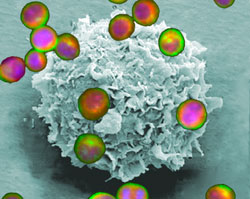09 August 2007
A microscopic sieve opens the way to earlier diagnosis of oral cancer, say US researchers.
Worldwide, oral cancer is the sixth most common cancer and is often fatal as many patients are not identified until the cancer is at an advanced stage. Current detection methods rely on the physical identification of a growth, followed by biopsy to identify whether the growth is cancerous.
"The device identifies cancer-related markers that are present before an obvious tumor is visible"
Now, John McDevitt and co-workers at the University of Texas, at Austin, have developed a sensor capable of identifying oral cancer at an early stage. The device identifies cancer-related markers, in this case a protein receptor called epidermal growth factor receptor, located on the surface of cells found in saliva and other body fluids. These are present before an obvious tumor is visible.

The device captures cancer cells on a microsieve membrane
The sensor is a multi-layer structure on a Perspex base. A cell culture suspension flows through the device, and a membrane within the base acts as a microsieve to capture marked cells before the suspension flows out. Once captured, the cells on the membrane are fluorescently labelled, automatically imaged and analysed. By comparing the labelled sensor to a control, it is possible to detect whether the sample contains the cancer markers.
The new sensor is much quicker than conventional techniques, taking under ten minutes to prepare the samples. It also requires significantly less sample and reagent, reducing cost. This opens the possibility of point-of-care oral cancer screening tools, said McDevitt. He added, follow-up visits to follow the progression of the disease after treatment are one area that may be particularly well suited for a portable oral cancer screening unit.
The team is currently collaborating with the University of Texas Health Science Center at San Antonio, with the support of the National Institute of Dental and Craniofacial Research Division of the National Institutes of Health, to take the new system into broad clinical use.
Vikki Chapman
www.rsc.org/Publishing/Journals/cb/Volume/2007/9/Sifting_out_cancer_cells.asp
Amira Kotb